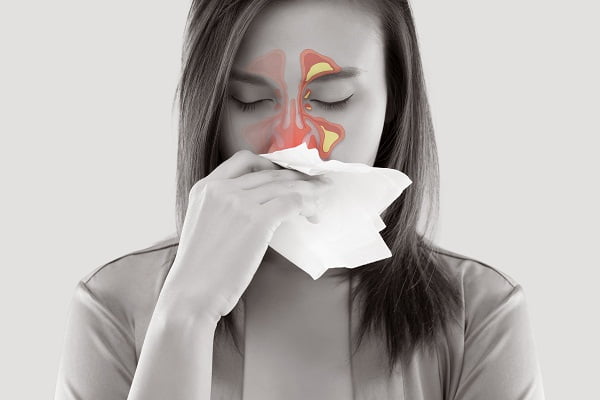
What is Sinusitis or Sinus Infection?
Sinuses are some hollow spaces in the body. There are various types of sinuses, but sinusitis affects the paranasal sinuses, the spaces behind the face that lead to the nasal cavity. The paranasal sinuses have the same mucous membrane lining like nose. They produce a slippery secretion called mucus, which keeps the nasal passages moist and traps dirt particles and germs. Sinusitis occurs when mucus builds up and the sinuses become swollen. Sinusitis is often called rhinosinusitus by doctors because sinus inflammation always occurs along with inflammation of the nose known as rhinitis.
Sinus infection or sinusitis is a common condition characterized by an inflammation of the sinuses and nasal passages. Sinusitis is actually sinus inflammation, usually caused by an infection. It is common and usually clears up on its own within 2 to 3 weeks. But medicines may be used if it is taking a longer time to go away. Medically known as rhino sinusitis, the sinus infection occurs when nasal cavities become infected, swollen, and inflamed. It is usually caused by a virus and often continues even after other upper respiratory symptoms are gone. In a very few cases, bacteria, or rarely fungus, may cause a sinus infection. Certain other conditions such as allergies, nasal polyps, and tooth infections can also result in severe sinus pain and symptoms.
Normally healthy sinuses are filled with air. But when they become blocked and filled with fluid, germs can grow up and cause an infection. Certain conditions that can cause blockage in the sinuses include:
- Common cold
- Allergic rhinitis
- Small growths in the lining of the nose called nasal polyps
- A deviated septum (shift in the nasal cavity)
Sinusitis can be acute or chronic and is caused by viruses, bacteria, fungi, allergies, or even some autoimmune reactions. In 2015, the Centers for Disease Control and Prevention (CDC) observed that 12.1 % of adults surveyed in the United States had been diagnosed with sinusitis in the previous 12 months.
Fast Facts on sinusitis
Some of the important facts about sinusitis are:
- People have four pairs of sinuses (hollow spaces behind the bones of the face)
- Allergies caused by bacteria or a virus can cause sinus inflammation
- Certain conditions can cause blockage in the sinuses leading to sinusitis
- It usually goes away on its own, but sometimes medical treatment is needed
- Chronic sinusitis lasts more than 12 weeks
Types of Sinusitis
Sinusitis or sinus infection can be usually of following types:
- Acute
- Sub acute
- Chronic
- Recurrent
Acute Sinusitis
This type of sinusitis usually starts all of a sudden and may last for two to four weeks. It is often characterized by cold like symptoms such as runny, stuffy nose and facial pain. Symptoms usually go away within 10 days but in some people, a bacterial infection develops.
Sub Acute Sinusitis
This type of sinusitis usually lasts 4 to 12 weeks.
Chronic Sinusitis
This type of sinusitis is non-bacterial in nature and often last for 12 weeks or more.
Recurrent Sinusitis
This type of sinusitis occurs several times in a year.
What Causes Sinusitis?
Sinus infection or sinusitis is caused by anything that interferes with airflow into the sinuses and the drainage of mucus out of the sinuses. The sinus openings (ostea) may be blocked due to swelling in the tissue lining and adjacent nasal passage tissue. It has been found that almost 35 million Americans have sinusitis at least once each year.
Sinusitis can occur due to various factors, but mostly it is due to build up of fluid in the sinuses which fuels the growth of germs. In case of adults, 90% of sinusitis is due to viral infections and 1 case in 10 is caused by bacteria. Besides, pollutants, chemicals, and irritants in the air can also trigger a buildup of mucus. Sometimes, sinuses either react to fungi in the air called allergic fungal sinusitis (AFS), or they are invaded by fungi, as in case of chronic indolent sinusitis. This is rare in the United States.
Sinusitis may be caused by some other causes also, which may include such as:
- Tumors or growths near sinus openings which may block the sinuses resulting in sinusitis
- Dehydration (lack of water content) in the mucus caused by medications like antihistamines
- Due to some fungal infections called as zygomycosis or mucormycosis.
- Swollen sinuses due to various infections
Sinusitis in children may be due to:
- Allergies
- Illnesses from other kids at day care or school
- Pacifiers
- Bottle drinking while lying on the back
- Smoke in the environment
Symptoms of Sinusitis
Sinusitis symptoms, whether acute or chronic, mostly develop after a cold or during times of severe or ongoing allergic rhinitis. The most common sign of sinusitis is a painful pressure in the cheeks and forehead. Certain other symptoms include:
- Postnasal drip
- Discolored nasal discharge (greenish in color)
- Nasal stuffiness or congestion
- Tenderness of the face, especially under the eyes or at the bridge of the nose
- Frontal headaches
- Pain in the teeth
- Coughing
- Fatigue
- Facial pain or pressure
- “Stuffed-up” nose
- Runny nose
- Loss of smell
- Fever
- Bad breath (halitosis)
- A feeling of congestion or fullness in face
- Pus in the nasal cavity
- Discolored postnasal drainage
- Sore throat
- Swollen sinuses
- Sneezing and itching in the nose
Risk Factors for Sinusitis
Many factors have been found to increase the risk of developing sinusitis. Some of them include:
- Previous respiratory tract infections like common cold
- Nasal polyps (small growths in the nasal passage that can lead to inflammation)
- Weak immunity due to a health condition or some kinds of treatment
- An allergic reaction to certain allergens like dust, pollen, and animal hair
- Some structural problems in the nose like a deviated septum. The septum is the bone and cartilage that divides the nose into two nostrils. When it is deviated towards one side, either through injury or growth, it can cause repeated infections and inflammation.
How is Sinus Infection Diagnosed?
Diagnosis of sinusitis mostly depends on symptoms and requires an examination of the throat, nose and sinuses. An allergist will look for:
- Redness
- Swelling of the nasal tissues
- Tenderness of the face
- Discolored (greenish) nasal discharge
- Bad Breath
- Swollen sinuses
If the sinus infection lasts more than eight weeks, or if standard antibiotic treatment is not working, a sinus CT scan may help an allergist in diagnosing the problem. An allergist may examine nose or sinus openings of the patient. The examination involves using a long, thin, flexible tube with a tiny camera and a light at one end that is inserted through the nose. It is not painful. The allergist may give a light anesthetic nasal spray to the patient so as to make him more comfortable.
In case of persistent chronic sinus infections, a mucus culture may help to determine what is causing the infection. Most mucus samples are taken from the nose. However, sometimes it is necessary to get mucus (or pus) directly from the sinuses.
Knowing the kind of bacteria responsible for the infection can be more useful for an effective antibiotic therapy. Sometimes, even a fungus can cause sinus infection, therefore confirming the presence of fungus is important. Fungal sinus infections are treated with antifungal agents, rather than antibiotics. However, some forms of fungal sinus infection (allergic fungal sinus infection) do not respond to antifungal agents and therefore require the use of oral steroids.
The extent of sinus infection can be determined with the help of sinus CT scan. Sometimes, an immunologist can also help in knowing the underlying factors for sinusitis such as allergies, asthma, structural defects, or a weakness of the immune system.
In case of serious types of fungal sinus infections, the fungus can penetrate into nearby bone. In such conditions, only a bone biopsy can help in determining whether it has happened or not. Besides, sinus tissue biopsies are also used to test for immotile cilia syndrome, a rare disorder that can cause recurrent infections in people, including chronic sinus infection, bronchitis and pneumonia.
Treatment of Sinus Infection or Sinusitis
The sinusitis treatment usually depends on the duration of sinus infection and may involve following options:
- Using saline nasal sprays
- Using nasal corticosteroids like fluticasone, budesonide, mometasone, and beclomethasone
- Decongestants
- OTC pain relievers like acetaminophen, ibuprofen, or aspirin
- Antibiotics
- Immunotherapy (allergy shots) to avoid body’s reaction to specific allergens
Prevention of Sinus Infection
Following measures may help in preventing sinus infections:
- Practicing good hand hygiene
- Avoiding smoking and second-hand smoke
- Keeping vaccinations up to date
- Staying away from people with colds and other respiratory infections
- Using clean humidifiers to moisten the air at home
- Maintaining air conditioning units to prevent mold and dust from collecting
- Avoiding exposure to different allergens






